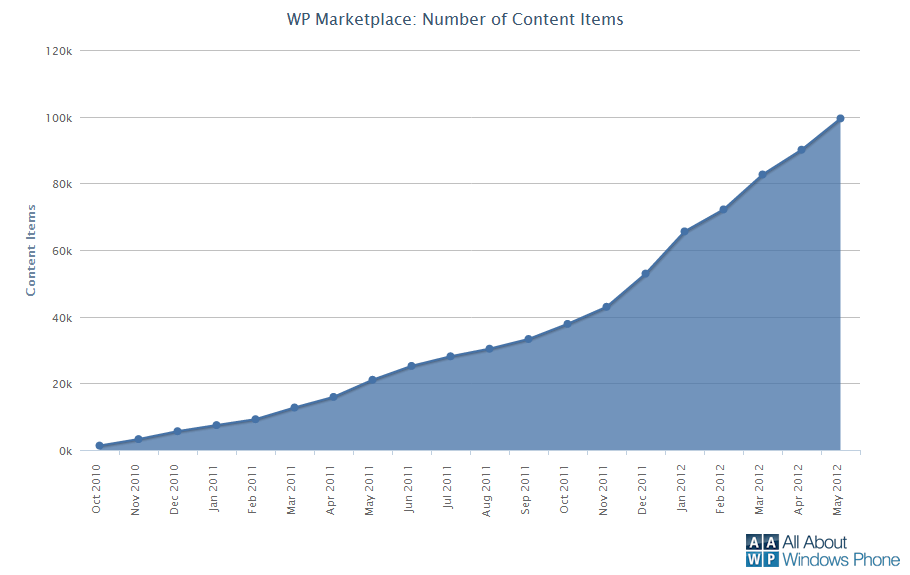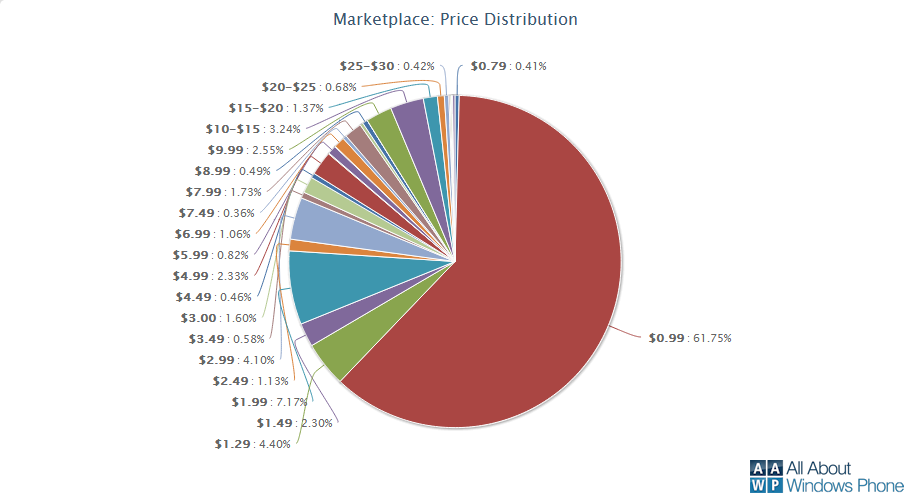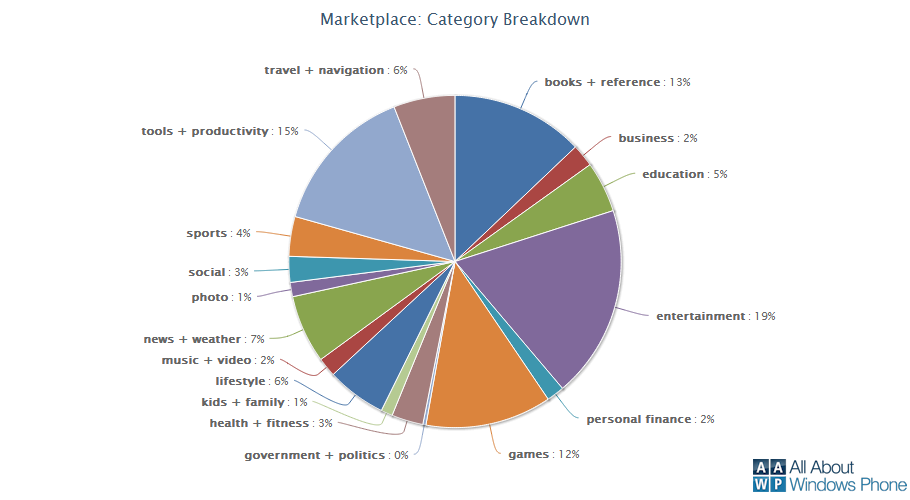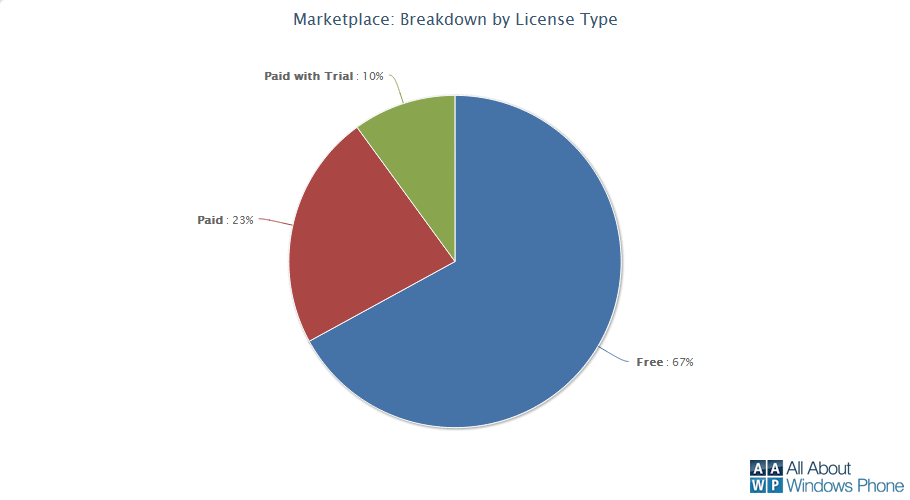Key points
As of June 3rd, 2012:
- 100,145 apps published to the Windows Phone Marketplace over the last 20 months
- 88,371 apps live (available for download, total across 60 countries)
- Windows Phone reached the 100,000 milestone faster than Android (24 months), but slower than iOS (16 months)
- 23,825 publishers (developers)
- Proportion of quality apps (rated five or more times) stable at 8% (UK ratings) 12% (US ratings)
It took Windows Phone 14 months to reach 50,000 apps, but only another 5 months to double that figure to 100,000. The 50,000 app mark was reached on December 27th, 2011, the 60,000 mark on January 22nd, 2012, the 70,000 mark on February 23rd, and the 80,000 milestone on March 26th, the 90,000 milestone on April 30th. It has taken an additional 33 days to reach the 100,000 mark.
Number of Content Items (Apps) Published
The graph below shows the growth in the total number of apps (content items) published to the Windows Phone Marketplace over the last 19 months.

In common with other application stores, the total number of published items is not the same as the number of items available to consumers. Of the 100,145 items published to the Marketplace, 10,357 are no longer available (withdrawn by Microsoft or unpublished by the developer), a further 1,492 items are in staging (awaiting an update, in beta or not live for some other reason). That means there are 88,371 apps currently available for download (live) on the Windows Phone Marketplace.

In addition, some apps are only available in select markets. This means the number of available items to a consumer, in a given market, is lower than the number of published items. The current figures for live apps (i.e. fully available for download) are: US (77,450), UK (72,933), France (69,879), Spain (68,361), Italy (68,180), Germany (69,153), Australia (70,036), Russia (55,052), Brazil (47,453) India (69,771) and China (33,063).
The graph below shows the number of live apps available in 59 countries. The 5 groupings visible in the chart align, roughly, with the date at which the country went live in the Marketplace. The five groups are Windows Phone launch (October 2010), Mango launch (October 2011), Expansion 3 (January 2012), Expansion 4 (March 2012), and Expansion 5 (April 2012).
 Some apps are only distributed in a single country. This usually applies to apps that contain region-restricted content or features, are hyper-local (only relevant o one country) or are only available in a single language. The chart below shows the number of single market distribution app for each country. Other apps are distributed in multiple countries, but not all the countries available in the Marketplace. Developers with such apps may be missing out on potential downloads.
Some apps are only distributed in a single country. This usually applies to apps that contain region-restricted content or features, are hyper-local (only relevant o one country) or are only available in a single language. The chart below shows the number of single market distribution app for each country. Other apps are distributed in multiple countries, but not all the countries available in the Marketplace. Developers with such apps may be missing out on potential downloads.

The majority of apps are published in English (68,529 of live total). A number of apps are localised into other languages, with German (6,231), French (5,627), Spanish (4401) and Italian (3225) being the most common. This represents a surprisingly small proportion of the total number of live apps. Given the importance of local content and the increased likelihood or buying/downloading an app if its available in your local language, localisation is an area that both Microsoft and developers themselves should be looking at more as the Marketplace continues to grow.

In May, an average of 313 apps were added to Windows Phone Marketplace per day. This was up from April and almost double the number from May 2011 (166 per day). The app addition rate has varied over the first 5 months of 2012, but the overall trend sees an increasing growth rate from 2011 to 2012.

Quality and quantity
As we previously noted, the quantity of apps is best used only as a guideline metric. The quality of apps in an app store is also very important, but is more difficult to judge objectively.
In January, we started looking at how many times an app has been rated as a metric. This can be seen as an analog for quality since only applications and games seen as useful are likely to be downloaded and rated multiple times (spam apps will be ignored). In the UK Marketplace (total 72,933) just over 5,600 apps have been rated 5 or more times. This figure has been stable for the last few months. For the US Marketplace the same figures are 77,450 and 9560 (12%) respectively.
As we noted in a previous report:
In app terms, there is no doubt that Windows Phone is, currently, in a weaker position than iOS and Android. In quantitative terms, it faces a seemingly Sisyphean task to gain parity with a moving target. Nonetheless, in qualitative terms, there is a point at which, as far as consumers are concerned, there is little or no difference.
Does 100,000 apps represent a psychological barrier at which point the number of apps stops mattering? That seems unlikely and, at the very least, the total app number is always going to be a footnote to any discussion about app availability. But perhaps it will matter less as app quality, functionality and discovery become more important. These metrics are harder to measure in a qualitative fashion, especially when making a comparison between app stores, so any app store that can create or promote a visible differentiator (e.g. app matching) may gain an advantage.
Content by category, license and pricing
The chart below shows the proportion of content in each of the Windows Phone Marketplace's top level categories. Entertainment remains the the single biggest category (18,867 items). The next three biggest categories are tools + productivity (14,591), books + reference (12,816 items) and games (12,212). The four biggest categories (out of seventeen) make up 59% of the content.
In May, Books + reference overtook games as the third biggest category as a result of a large number of single ebooks being added to the Windows Phone Marketplace.
The pie chart below shows the breakdown of the game section by sub-category (in the Windows Phone Marketplace, games has the most sub-categories, by some distance). The most popular sub-category is puzzle + trivia (4305 games - 35%), followed by action + adventure (1878 games - 15%) and classics (1692 games - 14%).

67% of items in the Windows Phone Marketplace are free, 10% are paid with a free trial and 23% are paid. In the last month there has been a small increase in the proportion of paid apps, but the more general trend (last 12 months) has seen the proportion of free apps slowly increase (by a few percentage points overall). The wider availability of advertising SDKs for Windows Phone and an increasing willingness, by developers, to try ad-supported business models is the primary reason for this.
The majority of paid apps fall into a few price points: $0.99 (61.8%) , $1.29 (4.4%), $1.49 (2.3%), $1.99 (7.7%), $2.99 (4.1%) or $4.99 (2.3%). Relatively few developers have taken advantage of the new price points, which were introduced last year (e.g. $0.79 - 0.41%).

Comparison with Android and iOS
Both Android and iOS (500,000+ and 600,000+ respectively) have at least five times more apps available than Windows Phone. However, this metric is, for obvious reasons, strongly correlated to how long an app store has been in operation. A more interesting comparison is to look at their relative performance.
Windows Phone has taken 20 months to reach the 100,000 milestone. Android took 24 months (October 2008 - October 2011) to reach 100,000 apps, reflecting Android's relatively slow start in terms of device licensees. iOS took 16 months (July 2008 - June 2009) to reach the same figure, but arguably had an advantage, given it had an installed base of around 4 million first generation iPhones before the App Store launched. Blackberry OS has just about reached the 100,000 figure (if you include Playbook Apps), and the Nokia Store took around 21 months (but includes apps for both Symbian, Maemo and Series 40 platforms).

This relative comparison would suggest that Windows Phone Marketplace is a credible challenger to both Apple's App Store and Google's Play in terms of app metrics. Both Android and iOS accelerated away from the 100,000 mark. It remains to be seen whether Windows Phone can do the same, but with Windows Phone 8 on the horizon it would be a reasonable assumption.
About
These numbers are from our own tracking system, which is also used to power the All About Windows Phone Apps and Games sections, where you can browse applications and games, and install them via links to the web-based Marketplace, or directly by scanning the QR Code with Bing Vision on your smartphone.
Every app available for Windows Phone has a unique App ID number (e.g. as used in the WindowsPhone.com links) and this is what we use track individual content items and keep count of how many unique apps are available for the platform.
If you're interested in getting additional insight or more detailed data, please get in touch and ask about the AAWP App Tracking service.
See Also
- Windows Phone Marketplace passes 35,000 apps
- Windows Phone Marketplace passes 40,000 apps
- Windows Phone Marketplace passes 50,000 apps
- Windows Phone Marketplace passes 60,000 apps
- Windows Phone Marketplace passes 70,000 apps
- Windows Phone Marketplace passes 80,000 apps
- Windows Phone Marketplace passes 90,000 apps


